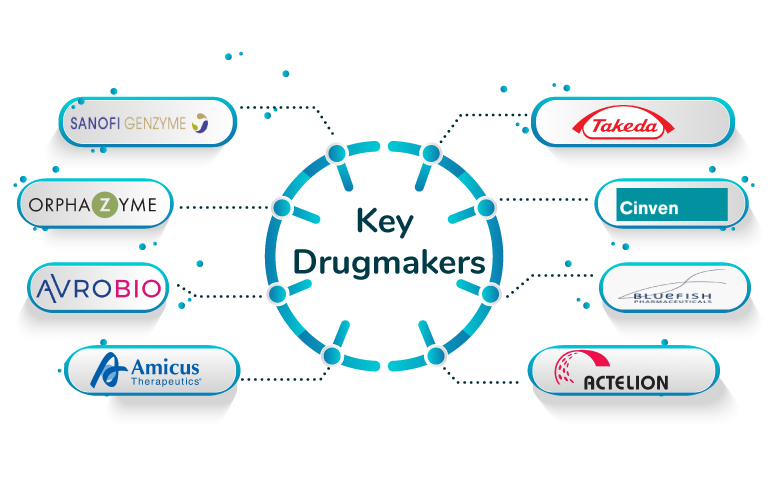Gaucher disease Market Analysis: Rich Pipeline Drives the Market Ahead
Dec 11, 2019
Table of Contents
Gaucher Disease Market is anticipated to enhance in the forecast period owing to a strong Gaucher disease pipeline.
According to the National Organization of Rare Diseases, Gaucher disease is a rare, inherited, metabolic disorder, which is characterized by an accumulation of harmful fats, chiefly the glycolipid glucocerebroside, in the whole body, more prominently in bone marrow, spleen, and liver.
Downloads
Article in PDF
Recent Articles
- Role of Mobile Technology in Hemophilia Management
- Sanifit nets USD 80.9 M; FDA approves Dupixent for CRS; AbbVie buys Allergan
- Rising of Orphan Drug Development
- Cost ineffective Orphan Drugs limit the access
- Novel Mutation-Targeting Therapies in the Horizon to Relieve the Global Healthcare Burden NSCLC P...
Despite being the most common lysosomal inherited disorder, Gaucher disease is a rare condition.
Deficiency of enzyme glucocerebrosidase (GCase) which has an important role in breaking down a fatty chemicals glucocerebrosidase, leads to the developing of Gaucher Disease. The accumulation of glucosylceramide (GC) and glucosyl sphingosine (GS) in lysosomes is considered one significant pathogenesis of the Gaucher disease.
Gaucher Disease can be segmented into three divisions or types based on their characteristic features. Type 1 Gaucher Disease, the most common type of Gaucher disease, is a condition which does not affect the brain and spinal cord of the patient. Thus, it is a treatable form and is referred to as non-neuropathic Gaucher disease. Symptoms of Type 1 Gaucher disease include an increase in the size of the liver, and spleen, anaemia, decreased RBC count, decreased platelets, bone abnormalities and lung diseases.
Type 2 and 3 Gaucher disease are neuropathic Gaucher disease since they afflict the central nervous system of the patient. Type 2 and 3 Gaucher diseases are accompanied by neurological issues such as seizures, along with the symptoms of Type 1 Gaucher disease. However, the progression of Type 3 Gaucher disease is slower than the Type 2 Gaucher disease. The major reason
Why the variability?
The associated mutations, which are the root cause of the Gaucher disease, are the main reason why the signs and symptoms differ with each type of Gaucher disease. As many as 300 types of mutations in the GBA gene are just associated with Type 1 Gaucher disease and over 50 mutations in the gene are behind the neuropathic forms of the Gaucher disease. Shockingly, the signs and symptoms of the disease vary with the disease. In a study, the symptoms of the Gaucher disease of one form failed to resemble the same form of the disease in different countries like China, Egypt and Sweden. This makes ethnical diversity another cause behind the varied symptoms and signs shown by the Gaucher disease patient pool.
According to the National Gaucher Foundation, it can affect anyone, and Gaucher disease prevalence is one in 40,000 live births. Gaucher disease is more common among Jews of Ashkenazi descent, and the figures in 2013 revealed that the Gaucher disease occurred in approximately 1 in 450, observed the NORD. Furthermore, 1 in 10 may also carry the mutated gene responsible for Gaucher disease.
According to a study by Paul et al., Gaucher disease prevalence was observed to be around 30 cases in one million of the German population.
However, Type 1 or non-neuropathic Gaucher disease prevalence is observed to be around 90-95% of the total cases of the Gaucher disease in Europe and America, as presented by Stirnemann et al., in a review article. Moreover, the median age of the Gaucher disease diagnosis was observed to be from 10-20 years and the overall mean onset of patients is 20.4 years old, the majority of patients experienced onset before 20.
Gaucher Disease Treatment Market
Gaucher disease has no cure.
However, in the past years, there has been an impressive scale of improvement in treating the symptoms of Gaucher disease Type 1. Significant cures to tackle bone abnormalities and organ enlargement are available in the Gaucher disease treatment market.
Without a doubt, due to the diversity in the mutations and variability in the manifestations, severity, and progression, the Gaucher disease treatment plan varies for the benefit of the patient.
The major goals of the Gaucher Disease Type 1 treatment are to prevent any permanent harm to the body. Enzyme Replacement Therapy (ERT) and Substrate Reduction Therapy (SRT) are the mainstays Gaucher disease Type 1 therapies used for improving the symptoms, prevention of irreversible complications, such as massive fibrous splenomegaly secondary osteoarthritis, vertebral compression, and other fractures; hepatic fibrosis and lung fibrosis. Overall, these therapies help in improving health and quality of life Gaucher Disease patients.
Moreover, several pain reregulating therapies, blood transfusions, and orthopaedic surgery are used for Gaucher disease management. ERT helps in compensating the low levels of enzyme GBA, by providing Glucocerebrosidase into the Gaucher cells. Enzyme Replacement Therapy helps in providing relief from the symptoms associated with hematologic, visceral, and bone in the Gaucher disease patients.
Some of the approved Gaucher disease Enzyme Replacement therapies are Cerezyme (imiglucerase), Elelyso (taliglucerase alfa), and Vpriv (velaglucerase alfa).
In the absence of ERT, Substrate Reduction Therapy (SRT) rescues the patients from the heavy accumulation of glucocerebroside (GlcCer). Approved Type 1 Gaucher Disease Substrate Reduction Therapy are Cerdelga (eliglustat), a therapy by Genzyme; and Zavesca (miglustat), a product of Actelion Pharmaceuticals.
Another therapeutic approach for treating Gaucher disease is Bone Marrow Transplantation. The therapy helps in replenishing the monocytes and preventing the problem of excess-accumulation.
Symptomatic treatment options for Gaucher disease include various pain reduction therapies, blood transfusions, orthopaedic surgery for bone and joints, and rare splenectomy.
In case of failure of ERT, splenectomy is used for the Gaucher disease patients, since it also increases the risk of developing infection, thrombosis, or neoplasia. Moreover, to help patients with pathological fractures and bone complications, Orthopedic surgery is recommended.
The growing demand for the standard and effective treatment option for Gaucher disease are driving the Gaucher disease treatment market forward. Looking at a number of unmet needs in Gaucher disease, there has been a large scale of Research being done to improve the Gaucher disease treatment landscape, yet there is a long way to go.
Presence of substantial therapies are one thing, and their likeliness to be used by the patients is another. Researchers have long been focused on finding a permanent cure in the form of Gene therapy for genetic disorders like Gaucher disease.
There remains a high unmet need for the development of improved treatments that combat neuronopathic complications at reduced costs and convenient administration schedule. Nevertheless, according to DelveInsight’s analysts, a hike in funding in research and healthcare facilities to treat rare diseases patients are projected to shape the future of the Gaucher disease treatment market. Also, an upsurge in the Gaucher disease prevalence will drive the demands in Gaucher disease treatment market.
Gaucher Disease Pipeline
With a motive to treat a morbid and burdensome rare inherited autosomal recessive disease, many pharma companies and healthcare institutions are investing to fuel the Gaucher disease market forward. In addition to these, some pharma companies have recently entered the Gaucher disease market.
Pharma companies like Sanofi-Genzyme, Orphazyme, AvroBio, Amicus therapeutics, Shire Plc, Cinven Ltd., Bluefish Pharmaceuticals, and many others are running clinical trials of their respective therapies to shape Gaucher disease market and help Gaucher disease patient pool to improve their quality of living.

Gaucher Disease Market Forecast
The Gaucher Disease type 1 market landscape is anticipated to change in the coming years, as per DelveInsight’s market observations, attributing to the improvement in the diagnosis methodologies, rising awareness of the diseases, incremental healthcare spending across the world, better healthcare insurance. The launch of emerging Gaucher disease therapies during the forecast period of 2019–2028 will further steer the Gaucher disease market in the right direction.
Venglustat (also known as GZ402671, Ibiglustat) is under development by Sanofi-Genzyme. The candidate is in Phase II stage of development of Gaucher Disease Type 1 and 3 treatment. Similarly, Arimoclomol (also known as BRX-345; OR-01) is under development by Orphazyme. The drug candidate is in Phase II stage development for Gaucher Disease Type 1 and 3 treatment.
Another promising agent such as AvroBio’s drug AVR-RD-02, is currently in phase I/II of the clinical trials in the race of tackling Gaucher disease. It is an ex-vivo lentiviral-based investigational gene therapy which holds the promise to provide a life-long therapeutic benefit to Gaucher disease patient pool.
Recently, in October 2019, the US Food and Drug Administration (FDA) has also granted Orphan-Drug Designation to AVR-RD-02 for Gaucher disease. The recommendation came after the successful results of the therapy in terms of safety and efficacy to treat Gaucher disease Type 1.
The Gaucher Disease type 1 pipeline boasts of a bright future for the Gaucher disease patients in the coming years. The current Gaucher disease market scenario also anticipates a positive shift in the market for a study period of 2017–2028.
Downloads
Article in PDF
Recent Articles
- Lilly to Acquire Versanis; FDA Approves Beyfortus for RSV in Infants; Alnylam Presented Updates o...
- Overcoming the prevailing unmet needs in Beta-Thalassemia Market
- Cholesterol drug Praluent successful in reducing heart risk
- Hemophilia A- Market Scenario
- Merck’s Keytruda Wins Another FDA Approval; Sanofi Pauses Trial of Myasthenia Gravis Drug, tolebr...



